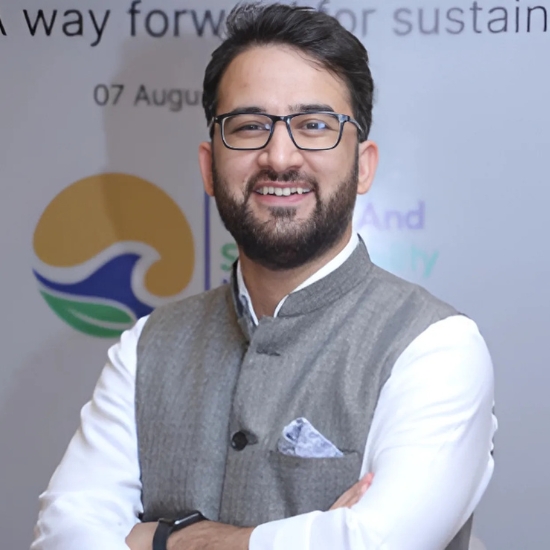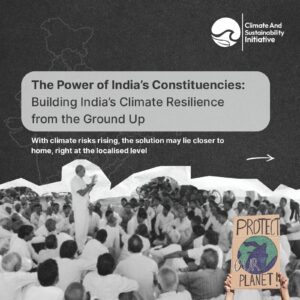Labour and economic productivity continue to decline as wet bulb temperatures rise in India. People living in slum dwellings or rural hinterlands face a dual challenge: enduring suboptimal living conditions while ensuring optimal productivity in their work environments. In 2024, a prolonged heatwave resulted in the loss of over 700 lives in India (Sebastian, 2025), reduced labour productivity by 20 per cent (Choubey, 2024), and doubled energy demand (Bose, 2025).
India’s annual maximum temperature is projected to increase by 1.5°C under the high-emission scenario by 2047, with winter temperatures in 139 districts expected to increase by 1.5°C (Kumar, 2024). Similarly, much of the Himalayan region may experience a temperature rise of 1.8°C (Menon, 2022). This will lead to decreased rainfall and unpredictable weather conditions, affecting energy requirements, food production, water security, and our daily lives.
By 2040, it is estimated that droughts could impact 40 per cent of India’s population (CEEW, 2020), leading to severe food shortages and worsening rural poverty. There is already a constant decline in annual crop yields because of irregular monsoon patterns and heat-induced stress (Das et al., 2025). In the Indian states of Punjab and Haryana, rice and wheat production have significantly declined due to climate change & rising temperature (Dhillon & Sohu, 2024). In 2023–24, climate-related disruptions in agricultural production across India resulted in an 11–12 per cent increase in food inflation in staple crops (Viglion, 2024). India has 21 of the 25 most polluted cities worldwide, with Delhi topping the list*. India urgently needs collective, converging, localised efforts involving stakeholders across the macro, meso, and micro contexts to drive change in samaj, sarkar, and bazaar (society, governance, and markets – or social, administrative, and economic change).
The need for localised climate action
India’s focus on climate resilience and transition planning has led to the design, development, and deployment of evidence-driven policy changes. However, traditional policy design often adopts a top-down approach, with information flowing from the government to the community but providing limited space for inputs from citizens or their representatives.
It is necessary to reevaluate the transition planning strategy from two perspectives: First, conceiving of customised location-specific interim scenarios is critical to support the transition in high-emission sectors and regions. This is pivotal because the energy sector accounts for 75.7 per cent of global emissions (Ge, Friedrich, & Vigna, 2024). Like other developing countries, India must create and adopt a framework to improve top-down understanding, but complement it with real-time, on-ground analysis. This will help bridge the gap between planning at the national level and needs at the community level.
For instance, while the focus on renewable energy has helped lower emissions in the electricity sector, it has also raised concerns about grid connectivity and insufficient transmission capacity infrastructure (Barth et al., 2024) – and the solution cannot come from the top alone. Likewise, heavy industries such as steel and cement cannot be decarbonised in the context of continued dependence on fossil fuels. There is a clear opportunity here to develop a targeted approach that bolsters green hydrogen production and introduces new carbon capture technologies that are cost-competitive, efficient, and accessible.
Besides, regional disparities are a significant factor in countries of the global south. For instance, urban areas currently generate 70 per cent of energy-related CO₂ emissions (Luqman, Rayner, & Gurney, 2023), while rural regions have lower per capita emissions. This further stresses the need for a customised approach to addressing these sectoral and geographical disparities. Second, climate-centric frameworks and approaches need to be developed and incorporated into existing programmes and schemes at the national level. Such cross-sectoral frameworks can offer actionable pathways for alignment with Sustainable Development Goals (SDGs), allowing equitable transitions and inclusive development.
One of the largest rural housing projects in the world, Pradhan Mantri Awas Yojana-Gramin (PMAY-G) in India, incorporated climate considerations in rural housing projects by using sustainable building materials** and energy-efficient designs (Ministry of Rural Development 2016). This initiative not only addressed the rural housing shortage but also reduced GHG emissions, ensuring affordable and environmentally sustainable housing.
While national and subnational governments in India have started taking steps in this direction through state action plans on climate change, localised low-carbon development models can further facilitate climate resilience. This approach might involve designing robust action plans for targeted interventions delivered through local institutions and pathways. One such method is to enable and assist members of parliament (MPs) and members of the legislative assembly (MLAs) to draft constituency-specific climate action plans that draw on MP and MLA development funds*** available at the district level. These plans can resemble the city-specific climate action plans being developed across India, with support from civic society organisations and think tanks (Panwar, 2021).
If such a climate-centric approach to development proves effective and yields satisfactory results, national and subnational governments can engage more deeply with the frontline leadership of panchayats (village councils) to enhance capacity and promote sustainable green development through both tied and untied funds at the gram panchayat level.
Why constituency-level climate action matters
Like all developing countries in the Global South, India will need trained legislators equipped to manage climate transitions within their constituencies and districts. With the district at the heart of implementation, legislators can offer crucial advisory support for decision-making by the administration. In several district-level committees, they already guide the conversation on development. They remain permanent invitees to the local DISHA committee****, the apex body for coordinating and monitoring development initiatives in the district, where the most senior MP is the chairperson. The DISHA committee acts as a catalyst for informed action, with elected representatives at the frontline, which is essential for development at the municipal level and for reshaping gram panchayat and district development plans within zila parishads (district councils).
In numbers, there are 545 Lok Sabha (lower house) MPs, 4,123 MLAs across states and union territories, and 245 Rajya Sabha (upper house) MPs in India (Election Commission of India, n.d.). Each MLA is allocated an average of INR 30 million (INR 3 crore) per annum for development activities for their constituency (Indian Express, 2023), implying a budget of INR 129 billion at the national level. Likewise, every MP is allocated INR 50 million (INR 5 crore) per annum; the total funds available to MPs and MLAs are INR 169 billion.
MPs and MLAs also recommend projects to the District Mineral Fund Trusts (PIB, 2022) and corporate social responsibility (CSR) grants, to finance developmental works by the competent authorities. As a result, MPs and MLAs become enablers of localised climate action models by spearheading constituency-centred initiatives and informing district development pathways. Plans thus tailored to each location optimise resource allocation – directly to projects or via the district administration – on a case-by-case basis.
What needs to be done?
While the budgets available to MP and MLA development funds may be insignificant compared to the populations they serve, they continue to be essential pillars of the public institutional framework. They play a crucial role in policy design and can inform conversations on transition planning and financing at the assembly or parliament level.
At the foundational level, MPs and MLAs can facilitate transition efforts that call for capacity building and supply constituency-level assessments of physical and financial climate risks. They are also well-placed to assess resource availability for adaptation and mitigation. This also helps them understand how climate change may affect all of us in our home constituencies, motivating them to guide climate-centred development initiatives and action plans. In turn, these plans can then potentially address other core challenges of that constituency, whether it is rising sea levels, water availability, agricultural vulnerabilities, floods, or other climate-related risks. These plans may serve as a guiding framework for:
- Local solution design focused on creating tailored sites to combat climate change, one community at a time. This method can yield data that informs national and subnational planning processes. Nigeria’s successful local adaptation to climate change exemplifies how communities, governments, and funders can collaboratively shape localised models (Coger et al., 2022).
- Building resilience at the ground level through engagement with relevant district stakeholders can help create a local knowledge pool, strengthen capacities, and enhance resilience. In doing so, communities, district officials, and leaders can become more informed and better prepared for future climate risks, reduce vulnerability, and promote long-term sustainability in their respective constituencies and districts.
- Empowering communities and leaders through initiatives such as the DISHA committee, the devolution of financial and administrative powers to gram panchayats, and schemes such as the Sansad Adarsh Gram Yojana (SAGY) can accelerate targeted actions while fostering a sense of ownership and collective responsibility (PMO, 2016). This, along with shaping priorities, supports agenda-setting at the local, subnational, and national levels and fosters an intersectional perspective on climate change.
- Contributing to national and global goals through constituency-level climate action can help countries, including India, fulfil their commitments under the Paris Agreement by taking a decentralised approach to climate change mitigation. Kerala has already begun piloting development plans at the panchayat level (The Hindu, 2024). Similarly, the Ministry of Urban and Housing Affairs has initiated this process at the city level (Ministry of Housing and Urban Affairs, 2025). This can further enhance efforts at the constituency level to establish a framework for district and sub-district plans.
By Imad Malik, Engagement Lead, Climate And Sustainability Initiative (CSI). Views expressed are personal.
__________________________
Footnotes
*PM2.5 levels averaged around 157.1 µg/m³, far exceeding the WHO’s safe limit of 5 µg/m³.
**Fly ash bricks (FABs) and autoclaved aerated concrete (AAC) blocks.
***MPLAD (Member of Parliament’s Local Area Development Scheme) and MLALAD (Member of Legislative Assembly’s Local Area Development) are government-funded initiatives that allow elected representatives in India to recommend local development projects for financial support. MPs and MLAs utilise these funds to support small-scale development projects in their constituencies, including constructing roads, community halls, toilets, water facilities, and improving schools or health centres. Although greening and climate-focused priorities may seem to compete with essential development needs, they can complement one another when thoughtfully integrated, such as by combining solar lighting with street development or rainwater harvesting with water supply systems.
****DISHA committees (District Development Coordination and Monitoring Committees), established in 2016, ensure effective coordination among elected representatives, local governments, and officials for the efficient implementation of development schemes. Chaired by the seniormost Lok Sabha MP from the district, they monitor progress on non-statutory schemes and facilitate convergence for impactful outcomes.
Bose, M. (2025). Heatwaves drove surge in electricity demand in 2024: Report. Deccan Herald.
Choubey, J. (2024). Rising heat damaging health and economy. The New Indian Express.
Election Commission of India. (n.d.). Term of the houses. Election Commission of India.
Sebastian, M. (2025). India’s Met office warns of intense heatwave this summer. BBC News.
Viglione, G. (2024). Experts: What is causing food prices to spike around the world? Carbon Brief.


